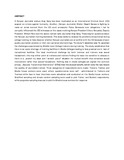| dc.contributor.author | Wefwafwa, Job Allan | |
| dc.date.accessioned | 2014-08-01T12:58:14Z | |
| dc.date.available | 2014-08-01T12:58:14Z | |
| dc.date.issued | 2008 | |
| dc.identifier.citation | Allan, Wefwafwa Job. "An Analysis Of The Challenges Hindering Effective Middle Level Media Training In Kenya; A Case Study Of Nairobi’s Public & Private Middle Level Media Training Colleges." | |
| dc.identifier.uri | http://hdl.handle.net/11295/73519 | |
| dc.description.abstract | A Kenyan Journalist Joshua Arap Sang has been implicated as an International Criminal Court (ICC) suspect on crimes against humanity. Another, (Kenyan Journalist) Walter Osapili Barasa is fighting to resist an arrest warrant from the ICC court prosecutor Fatou Bensouda over allegations t hat he corruptly influenced the ICC witnesses on the cases involving Kenyan President Uhuru Kenyatta, Deputy President William Ruto and the above named radio Journalist Arap Sang. These beg for questions about the Kenyan Journalism training standards. This study seeks to analyse the problems encountered during college training; to help discover whether Kenyan journalists are at conflict with the ICC because of poor quality journalism practice or their own personal shortcomings. The study‟s objective was: To ascertain the challenges experienced by Middle Level College trainers during training. The study established that there is an acute shortage of training facilities in Media Colleges leading to less practical work, lack of recreational facilities. The least mentioned challenge by both trainees and trainers was sexual harassment; this may either point at trainees and trainers finding the issue too sensitive to discuss or there is a „scratch my back and I scratch yours‟ situation for mutual benefit thus conscious sexual involvement rather than sexual harassment. Nothing else in media colleges can explain the common phrase, „Sexually Transmitted Distinctions‟ (STDs) than the mutual benefit; which none the less lowers the quality of journalists trained. Three categories of respondents were made: Trainers, Trainee and Media house workers were used; where questionnaires were self - administered to Trainers and Trainees while face to face Interviews were scheduled and conducted on the Media house workers. Stratified sampling and simple random sampling were used to pick Trainer and Student respondents; while purposive sampling was use to pick the Media house workers for response | en_US |
| dc.description.uri | http://www.ijirs.com/vol3_issue-2/43.pdf | |
| dc.language.iso | en | en_US |
| dc.publisher | University of Nairobi, | en_US |
| dc.title | An Analysis Of The Challenges Hindering Effective Middle Level Media Training In Kenya; A Case Study Of Nairobi’s Public & Private Middl e Level Media Training Colleges | en_US |
| dc.type | Article | en_US |
| dc.type.material | en | en_US |

